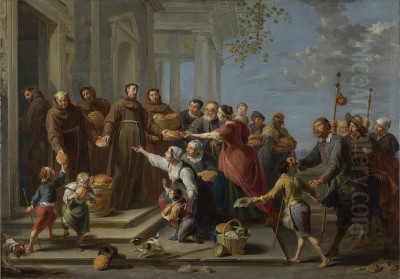
Willem van Herp the Elder, also known by variants such as Guilliam or Guillaume van Herp, stands as a notable figure within the vibrant artistic milieu of 17th-century Antwerp. Active during the height of the Flemish Baroque period, he carved a niche for himself primarily as a painter of religious subjects and lively genre scenes. Born around 1613 or 1614 in Antwerp, he remained deeply connected to his native city throughout his life, becoming a master in its prestigious Guild of Saint Luke and contributing significantly to its artistic output until his death in 1677. While perhaps not possessing the towering originality of some of his contemporaries, Van Herp was a highly skilled and prolific artist whose work found considerable favour both locally and internationally, particularly in Spain.
Early Life and Artistic Formation
Details surrounding Willem van Herp's earliest years are relatively scarce, as is common for many artists of the period. However, records indicate his birth in Antwerp around 1614. His artistic training began under the tutelage of lesser-known masters. Sources suggest he was apprenticed first to Damiaan Wortelmans II from around 1625. Wortelmans himself came from a family involved in the arts, though his individual fame was limited. Following this initial training, Van Herp is recorded as having studied with Hans Biermans, another Antwerp painter about whom less is known today.
This period of apprenticeship would have immersed the young Van Herp in the technical skills and stylistic conventions prevalent in Antwerp's workshops. He would have learned the fundamentals of drawing, paint preparation, composition, and the handling of different supports, including the copper plates he would frequently favour later in his career. The artistic environment of Antwerp at this time was dominated by the towering figure of Peter Paul Rubens, whose influence permeated nearly every workshop. Even through relatively minor masters, the stylistic innovations of Rubens and other leading artists like Anthony van Dyck and Jacob Jordaens would have been part of Van Herp's formative experience.
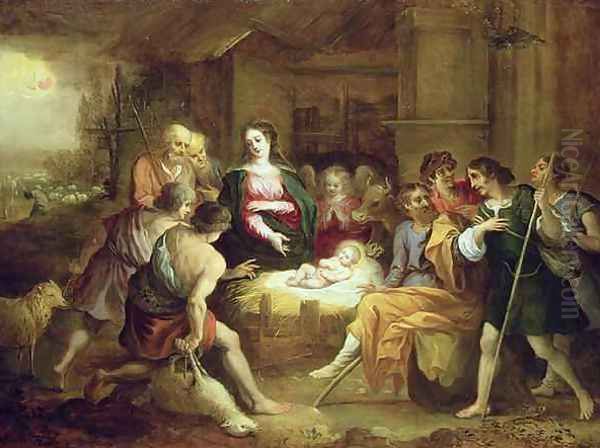
His formal training culminated in his acceptance as a master (vrijmeester) into the Antwerp Guild of Saint Luke in the guild year 1637-1638. This membership was crucial, granting him the right to establish his own workshop, take on apprentices, and sell his works independently within the city. It marked the official beginning of his professional career as an independent artist in one of Europe's most dynamic art centres.
Artistic Style: Eclecticism and Influence
Willem van Herp the Elder's artistic style is best characterized as eclectic, skillfully blending influences from various major figures of the Flemish and Italian Baroque. He was not an innovator in the mould of Rubens or Rembrandt, but rather a talented synthesizer and adapter, capable of working convincingly in manners derived from others. His ability to absorb and reinterpret prevailing styles contributed significantly to his success in the competitive Antwerp art market.
The Shadow of Rubens
The most profound and undeniable influence on Willem van Herp's work was Peter Paul Rubens. Antwerp was saturated with Rubens's art – large altarpieces in churches, mythological scenes in private collections, and numerous prints disseminating his compositions far and wide. Van Herp frequently borrowed compositional structures, figure types, and dynamic energy directly from Rubens. He produced numerous variations, copies, and pastiches based on Rubens's famous works.
This practice was common at the time and not necessarily viewed negatively; it demonstrated an artist's skill and alignment with the dominant, highly admired style. Van Herp often adapted Rubens's grand-scale compositions into smaller cabinet formats, frequently executed on copper, making the Rubenesque aesthetic accessible to a wider range of collectors who might not afford or have space for a monumental original. His religious scenes, in particular, often rework motifs and arrangements pioneered by Rubens, albeit sometimes with a slightly cooler palette or a more meticulous finish suited to the smaller scale.
Other Flemish Masters
Beyond Rubens, Van Herp also absorbed lessons from other leading Flemish painters. The elegant portraiture and refined religious sentiment found in the works of Anthony van Dyck can sometimes be detected in the grace of Van Herp's figures. The robust earthiness and crowded compositions of Jacob Jordaens also find echoes in some of Van Herp's more bustling scenes, particularly those depicting peasant life or biblical narratives filled with numerous figures.
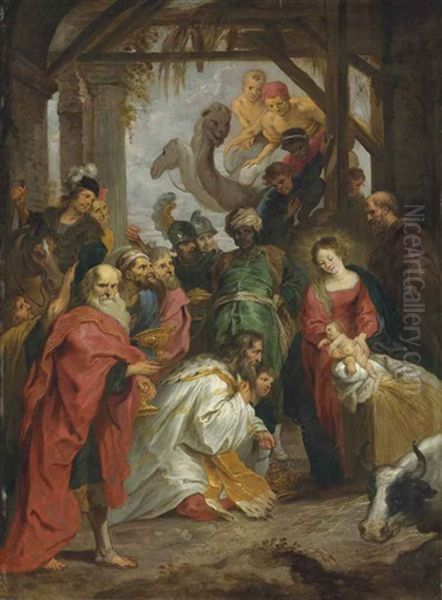
Furthermore, his genre scenes, depicting taverns, village festivals, or domestic interiors, clearly show the influence of David Teniers the Younger. Teniers the Younger was a master of capturing everyday life with keen observation and a lively touch. Van Herp adopted similar themes and sometimes a similar palette and figure style for his own genre paintings, contributing to the popularity of this type of work in the Antwerp market.
Echoes of Italy
Like many Northern European artists of his time, Van Herp was also aware of developments in Italian art, even if he is not documented as having travelled to Italy himself. The dramatic lighting and intense realism of Caravaggio, known as Caravaggism, had a significant impact across Europe, and its effects can be seen in the strong chiaroscuro (contrasts of light and shadow) employed in some of Van Herp's works to heighten emotional intensity, particularly in nocturnal religious scenes.
The influence of High Renaissance and Bolognese classicism is also apparent. Figures and compositional elements reminiscent of Raphael or the Carracci school, particularly Annibale Carracci, sometimes appear. The elegance and idealized beauty promoted by Bolognese painters like Guido Reni are also reflected in certain figure types and the smooth finish Van Herp occasionally employed. These Italian influences were likely absorbed through prints, copies, and original Italian works that circulated among Antwerp artists and collectors.
Technical Skill and Characteristics
Willem van Herp was a technically proficient painter. He often favoured working on copper plates, a support that allows for a smooth, detailed finish and enhances the luminosity of colours. His works on copper are typically small to medium in size, fitting the category of cabinet paintings intended for private contemplation and display in domestic interiors or collectors' cabinets.
His brushwork could vary. In some works, particularly those closely following Rubens, it is fluid and energetic. In others, especially his small-scale genre scenes or works on copper, it tends to be more meticulous and detailed, with careful attention paid to textures and surfaces. His colour palette often features rich reds, blues, and yellows, balanced with earthy tones, reflecting the general tendencies of the Flemish Baroque. He demonstrated considerable skill in depicting expressive figures, complex multi-figure compositions, and atmospheric settings.
Subject Matter and Major Works
Willem van Herp the Elder's oeuvre is dominated by religious subjects, but he also produced a significant number of genre scenes and, less frequently, mythological or allegorical paintings. His versatility across these themes contributed to his market appeal.
Religious Paintings
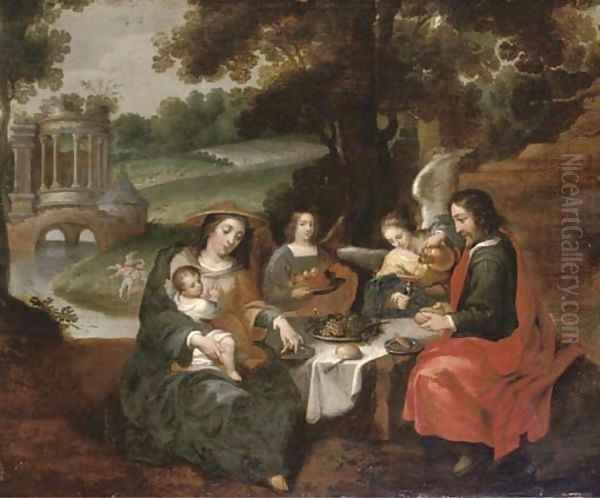
Religious narratives formed the core of Van Herp's production. He drew extensively from both the Old and New Testaments, as well as the lives of saints. His works often depict popular Counter-Reformation themes emphasizing piety, miracles, and divine intervention. These paintings ranged from intimate devotional images to more complex, multi-figure scenes suitable for private chapels or wealthy homes.
One of his most characteristic and frequently repeated subjects is Saint Anthony of Padua Distributing Bread. Several versions exist, including a notable example in the Prado Museum, Madrid. These paintings typically show the Franciscan saint surrounded by the poor and hungry, performing an act of charity. The compositions are often crowded and dynamic, showcasing Van Herp's ability to manage numerous figures and create a sense of communal activity, often drawing inspiration from similar charitable scenes by Rubens or Van Dyck.
Another significant work, also in the Prado, is Moses Saved from the Waters. This Old Testament scene allowed Van Herp to depict courtly figures in rich attire alongside the infant Moses, set against a landscape backdrop, combining narrative interest with decorative appeal. Other common religious themes in his work include the Adoration of the Shepherds, the Adoration of the Magi, scenes from the Passion of Christ, and depictions of martyrdoms or miracles of various saints. Noah's Sacrifice after the Flood is another theme he addressed, allowing for the depiction of animals and a landscape setting alongside the central religious figures.
Genre Scenes
Alongside his religious output, Van Herp was adept at painting genre scenes, capturing aspects of contemporary Flemish life. These works often depict peasants carousing in taverns, families gathered in rustic interiors, village celebrations, or allegorical representations of the senses or proverbs. These paintings align closely with the tradition established by Adriaen Brouwer and popularized by David Teniers the Younger.
Van Herp's genre scenes are typically lively and filled with anecdotal detail. He excelled at portraying expressive interactions between figures, capturing moments of humour, conviviality, or everyday labour. Works like Peasants Celebrating in an Inn or Interior with a Family Saying Grace exemplify his contribution to this popular category. These paintings often provided moral commentary or simply celebrated the vibrancy of Flemish folk culture, finding a ready market among the urban bourgeoisie.
Workshop, Collaboration, and the Art Market
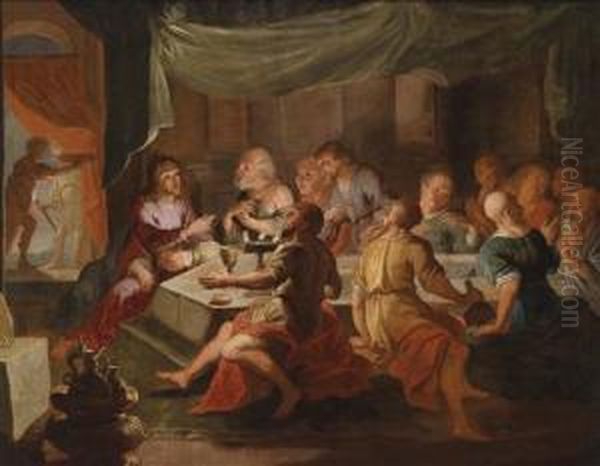
Willem van Herp operated a productive workshop in Antwerp, catering to a growing demand for paintings. Like many successful artists of his time, his production likely involved assistants who helped prepare panels, lay down underpainting, or even paint secondary elements, allowing him to increase output. The repetition of successful compositions, with variations in detail or format, was a common workshop practice aimed at efficiently meeting market demand.
Collaboration with Dealers
Van Herp maintained a close working relationship with prominent Antwerp art dealers, most notably Matthijs Musson. Musson was a key figure in the Antwerp art trade, facilitating the sale and export of paintings by numerous artists. Records show significant transactions between Van Herp and Musson, indicating that Van Herp supplied Musson with a steady stream of works, particularly cabinet paintings on copper.
These dealers played a crucial role in disseminating Flemish art across Europe. Musson, along with other firms like the Forchondt family, had extensive networks, particularly in Spain, Paris, and Vienna. A large number of Van Herp's paintings, especially his religious works on copper, found their way to Spain through these channels, contributing to his historical reputation in that country. This export market was vital for many Antwerp painters during the 17th century.
Collaboration with Artists
Collaboration between specialist painters was a hallmark of the Antwerp art world. While Van Herp was capable of painting diverse subjects himself, evidence and stylistic analysis suggest he may have collaborated with other artists on occasion. It is documented or strongly suggested that he worked with the renowned genre painter David Teniers the Younger. In some instances, one artist might paint the figures while the other executed the landscape or architectural setting.
He may also have collaborated with still-life specialists like Jan van Kessel the Elder for garlands or decorative elements in certain compositions, or with landscape painters for backgrounds, although specific documented instances beyond Teniers are less common. His association with figures like the painter Jan van Hoeck or the engraver/publisher Jacques Jodart places him firmly within the network of interacting artists and artisans in mid-17th century Antwerp. These collaborations allowed artists to play to their strengths and produce complex works more efficiently.
Later Life and Legacy
Willem van Herp the Elder remained active as a painter in Antwerp throughout his life. He continued to produce works for the local and international market until his death. He was buried in Antwerp's St. James' Church on June 25, 1677. His son, Willem van Herp the Younger (II), also became a painter, following in his father's footsteps, though his work is less well-known and often difficult to distinguish from his father's later output. Another son, Peter Willemsen van Herp, also trained as a painter.
In the broader sweep of art history, Willem van Herp the Elder is positioned as a significant secondary master of the Flemish Baroque. He was not a groundbreaking innovator like Rubens, Van Dyck, or Jordaens, nor did he achieve the focused mastery of a specialist like Teniers the Younger in genre or Jan Brueghel the Elder in flower painting. His strength lay in his versatility, his technical competence, and his ability to skillfully synthesize the styles of the leading masters of his day.
His primary contribution was arguably the popularization and dissemination of the Rubenesque style through more accessible, smaller-scale works. His paintings provided a way for a wider clientele, including those outside the highest echelons of church and state patronage, to own works that reflected the dominant artistic taste of the era. His considerable output, particularly the numerous works exported to Spain, ensured his name and style were recognized internationally during his lifetime and beyond.
While later art historical assessments often emphasize his derivative tendencies, his work continues to be appreciated for its craftsmanship, lively narratives, and reflection of the rich artistic culture of 17th-century Antwerp. His paintings are held in major museums worldwide, including the Prado Museum (Madrid), the Hermitage Museum (St. Petersburg), the Kunsthistorisches Museum (Vienna), and numerous regional museums and private collections, testifying to his enduring, if secondary, place in the history of Flemish art.
Conclusion
Willem van Herp the Elder was a quintessential Antwerp painter of the Baroque era. Rooted in the traditions of his city and trained within its guild system, he built a successful career by skillfully navigating the artistic currents of his time. Deeply influenced by Rubens yet responsive to other Flemish and Italian trends, he created a diverse body of work encompassing religious devotion, everyday life, and mythological fancy. Through his prolific output and connections with the international art trade, he played a significant role in spreading the visual language of the Flemish Baroque, particularly to Spain. While often working in the shadow of greater masters, Van Herp's technical skill and adaptive talent secured him a lasting place as a respected and characteristic representative of Antwerp's golden age of painting.